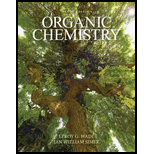
(a)
Interpretation:
The
Concept introduction:
The reaction between
(b)
Interpretation:
The amine and carbonyl compound that will combine to provide the given derivative are to be stated.
Concept introduction:
The reaction between ketone/aldehyde and ammonia derivatives in mild acidic condition comprises two steps. First is the acid catalyzed addition of the amine to the carbonyl group. Second is acid catalyzed dehydration to get the desired product (an imine).
(c)
Interpretation:
The amine and carbonyl compound that will combine to provide the given derivative are to be stated.
Concept introduction:
The reaction between ketone/aldehyde and ammonia derivatives in mild acidic condition comprises two steps. First is the acid catalyzed addition of the amine to the carbonyl group. Second is acid catalyzed dehydration to get the desired product (an imine).
(d)
Interpretation:
The amine and carbonyl compound that will combine to provide the given derivative are to be stated.
Concept introduction:
The reaction between ketone/aldehyde and ammonia derivatives in mild acidic condition comprises two steps. First is the acid catalyzed addition of the amine to the carbonyl group. Second is acid catalyzed dehydration to get the desired product (an imine).
(e)
Interpretation:
The amine and carbonyl compound that will combine to provide the given derivative are to be stated.
Concept introduction:
The reaction between ketone/aldehyde and ammonia derivatives in mild acidic condition comprises two steps. First is the acid catalyzed addition of the amine to the carbonyl group. Second is acid catalyzed dehydration to get the desired product (an imine).
(f)
Interpretation:
The amine and carbonyl compound that will combine to provide the given derivative are to be stated.
Concept introduction:
The reaction between ketone/aldehyde and ammonia derivatives in mild acidic condition comprises two steps. First is the acid catalyzed addition of the amine to the carbonyl group. Second is acid catalyzed dehydration to get the desired product (an imine).
Want to see the full answer?
Check out a sample textbook solution
Chapter 18 Solutions
Organic Chemistry (9th Edition)
- Classify each molecule as optically active or inactive. Determine the configuration at each H соон Chirality center OH 애 He OH H3C Ноос H H COOH A K B.arrow_forwardQ1: Rank the relative nucleophilicity of the following species in ethanol. CH3O¯, CH3OH, CH3COO, CH3COOH, CH3S Q2: Group these solvents into either protic solvents or aprotic solvents. Acetonitrile (CH3CN), H₂O, Acetic acid (CH3COOH), Acetone (CH3COCH3), CH3CH2OH, DMSO (CH3SOCH3), DMF (HCON(CH3)2), CH3OHarrow_forwardDon't used hand raiting and don't used Ai solutionarrow_forward
- 10. The main product of the following reaction is [1.1:4',1"-terphenyl]-2'-yl(1h-pyrazol-4- yl)methanone Ph N-H Pharrow_forwardDraw the Fischer projection for a D-aldo-pentose. (aldehyde pentose). How many total stereoisomers are there? Name the sugar you drew. Draw the Fischer projection for a L-keto-hexose. (ketone pentose). How many total stereoisomers are there? Draw the enantiomer.arrow_forwardDraw a structure using wedges and dashes for the following compound: H- Et OH HO- H H- Me OHarrow_forward
- Which of the following molecules are NOT typical carbohydrates? For the molecules that are carbohydrates, label them as an aldose or ketose. HO Он ОН ОН Он ОН но ΤΗ HO ОН HO eve Он он ОН ОН ОН If polyethylene has an average molecular weight of 25,000 g/mol, how many repeat units are present?arrow_forwardDraw the a-anomer cyclized pyranose Haworth projection of the below hexose. Circle the anomeric carbons. Number the carbons on the Fischer and Haworth projections. Assign R and S for each chiral center. HO CHO -H HO -H H- -OH H -OH CH₂OH Draw the ẞ-anomer cyclized furanose Haworth projection for the below hexose. Circle the anomeric carbons. Number the carbons on the Fischer and Haworth projections. HO CHO -H H -OH HO -H H -OH CH₂OHarrow_forwardName the below disaccharide. Circle any hemiacetals. Identify the numbering of glycosidic linkage, and identify it as a or ẞ. OH HO HO OH HO HO HO OHarrow_forward
- What are the monomers used to make the following polymers? F. а. b. с. d. Вецер хочому なarrow_forward1. Propose a reasonable mechanism for the following transformation. I'm looking for curved mechanistic arrows and appropriate formal charges on intermediates. OMe MeO OMe Me2N NMe2 OTBS OH xylenes OMe 'OTBSarrow_forwardWhat is the polymer made from the following monomers? What type of polymerization is used for each? а. ОН H2N но b. ن -NH2 d. H₂N NH2 довarrow_forward
 Organic Chemistry: A Guided InquiryChemistryISBN:9780618974122Author:Andrei StraumanisPublisher:Cengage Learning
Organic Chemistry: A Guided InquiryChemistryISBN:9780618974122Author:Andrei StraumanisPublisher:Cengage Learning Organic And Biological ChemistryChemistryISBN:9781305081079Author:STOKER, H. Stephen (howard Stephen)Publisher:Cengage Learning,
Organic And Biological ChemistryChemistryISBN:9781305081079Author:STOKER, H. Stephen (howard Stephen)Publisher:Cengage Learning, General, Organic, and Biological ChemistryChemistryISBN:9781285853918Author:H. Stephen StokerPublisher:Cengage Learning
General, Organic, and Biological ChemistryChemistryISBN:9781285853918Author:H. Stephen StokerPublisher:Cengage Learning Chemistry: The Molecular ScienceChemistryISBN:9781285199047Author:John W. Moore, Conrad L. StanitskiPublisher:Cengage Learning
Chemistry: The Molecular ScienceChemistryISBN:9781285199047Author:John W. Moore, Conrad L. StanitskiPublisher:Cengage Learning



